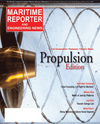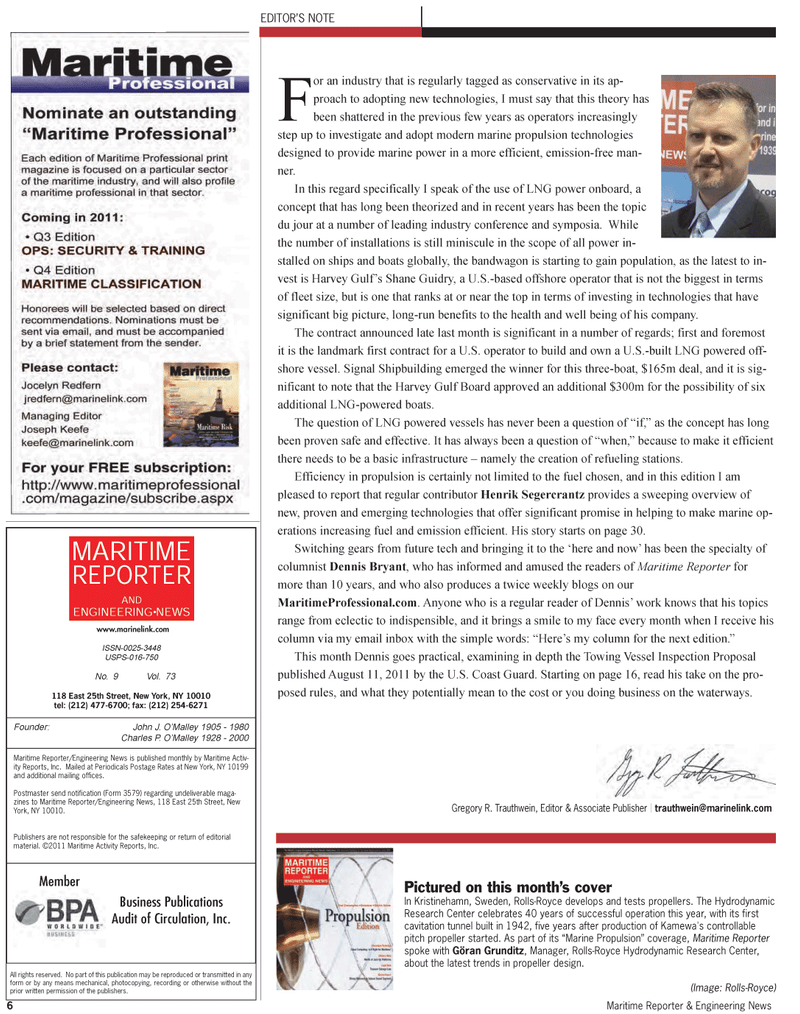
Page 6: of Maritime Reporter Magazine (September 2011)
Marine Propulsion Annual
Read this page in Pdf, Flash or Html5 edition of September 2011 Maritime Reporter Magazine
6Maritime Reporter & Engineering News EDITORS NOTEFor an industry that is regularly tagged as conservative in its ap- proach to adopting new technologies, I must say that this theory has been shattered in the previous few years as operators increasingly step up to investigate and adopt modern marine propulsion technologies designed to provide marine power in a more efficient, emission-free man- ner. In this regard specifically I speak of the use of LNG power onboard, a concept that has long been theorized and in recent years has been the topicdu jour at a number of leading industry conference and symposia. While the number of installations is still miniscule in the scope of all power in- stalled on ships and boats globally, the bandwagon is starting to gain population, as the latest to in- vest is Harvey Gulf?s Shane Guidry, a U.S.-based offshore operator that is not the biggest in terms of fleet size, but is one that ranks at or near the top in terms of investing in technologies that have significant big picture, long-run benefits to the health and well being of his company. The contract announced late last month is significant in a number of regards; first and foremost it is the landmark first contract for a U.S. operator to build and own a U.S.-built LNG powered off- shore vessel. Signal Shipbuilding emerged the winner for this three-boat, $165m deal, and it is sig- nificant to note that the Harvey Gulf Board approved an additional $300m for the possibility of six additional LNG-powered boats. The question of LNG powered vessels has never been a question of ?if,? as the concept has long been proven safe and effective. It has always been a question of ?when,? because to make it efficient there needs to be a basic infrastructure ? namely the creation of refueling stations.Efficiency in propulsion is certainly not limited to the fuel chosen, and in this edition I am pleased to report that regular contributor Henrik Segercrantz provides a sweeping overview of new, proven and emerging technologies that offer significant promise in helping to make marine op- erations increasing fuel and emission efficient. His story starts on page 30. Switching gears from future tech and bringing it to the ?here and now? has been the specialty of columnistDennis Bryant, who has informed and amused the readers of Maritime Reporterformore than 10 years, and who also produces a twice weekly blogs on ourMaritimeProfessional.com . Anyone who is a regular reader of Dennis? work knows that his topics range from eclectic to indispensible, and it brings a smile to my face every month when I receive his column via my email inbox with the simple words: ?Here?s my column for the next edition.? This month Dennis goes practical, examining in depth the Towing Vessel Inspection Proposal published August 11, 2011 by the U.S. Coast Guard. Starting on page 16, read his take on the pro- posed rules, and what they potentially mean to the cost or you doing business on the waterways. Founder:John J. O?Malley 1905 - 1980 Charles P. O?Malley 1928 - 2000 Maritime Reporter/Engineering News is published monthly by Maritime Activ- ity Reports, Inc. Mailed at Periodicals Postage Rates at New York, NY 10199 and additional mailing offices. Postmaster send notification (Form 3579) regarding undeliverable maga- zines to Maritime Reporter/Engineering News, 118 East 25th Street, New York, NY 10010. Publishers are not responsible for the safekeeping or return of editorial material. ©2011 Maritime Activity Reports, Inc. 118 East 25th Street, New York, NY 10010 tel: (212) 477-6700; fax: (212) 254-6271ISSN-0025-3448USPS-016-750No. 9Vol. 73 MemberBusiness Publications Audit of Circulation, Inc.www.marinelink.com MARITIMEREPORTER ANDENGINEERINGNEWS All rights reserved. No part of this publication may be reproduced or transmitted in any form or by any means mechanical, photocopying, recording or otherwise without the prior written permission of the publishers.Gregory R. Trauthwein, Editor & Associate Publisher [email protected] on this months cover In Kristinehamn, Sweden, Rolls-Royce develops and tests propellers. The Hydrodynamic Research Center celebrates 40 years of successful operation this year, with its first cavitation tunnel built in 1942, five years after production of Kamewa's controllable pitch propeller started. As part of its Marine Propulsion? coverage, Maritime Reporter spoke with Göran Grunditz, Manager, Rolls-Royce Hydrodynamic Research Center, about the latest trends in propeller design. (Image: Rolls-Royce)

 5
5

 7
7
